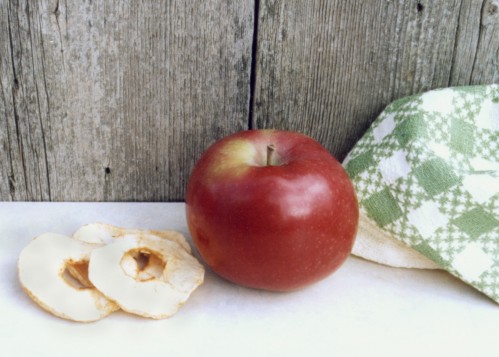

MCINTOSH
| Origin | Dundela, Ontario, about 1811. |
| Parentage | Unknown. Fameuse type, possibly Fall St. Lawrence - Emperor Alexander. |
| Availability | Mid September to mid June or later of the following year. |
| Source | Widely available and in several selected strains. |
| Quality | Fairly distinctive. Aromatic, sweet and juicy with a nice balance of mild acid, crisp, tender, melting flesh. Skin may seem somewhat tough in ripe fruits. |
| Fruit: |
| Size | Medium. Somewhat variable depending on season, orchard and crop load. |
| Surface | Smooth, glossy, fairly regular. Occasional fruits may be somewhat elongated. |
| Ground Colour | Light green fading to yellowish green and to cream as the fruit matures and ripens. |
| Over Colour | Blushed red, may be partially striped. Red becomes brighter as the fruit ripens. There is some variability among strains. Red colour will eventually develop on the tree without exposure to direct sunlight. |
| Flesh Colour | Creamy white. |
| Pressure | 16.5 - 17.5 lbs. |
| Harvest Season | Mid September to early October depending on season, strain and type of storage/market destiny. |
| Storage | Cold storage for all but immediate sale; Controlled Atmosphere and low O2 for storage over ten months. Recommended procedures have been extensively researched and should be carefully followed for best results. |
| Strains | A wide selection. Summerland has been one of the better standard types. For spur type trees - Greeslade (Macspur™) and Dewar; for earlier maturity - Marshall; for later maturity - Redmax and Summerland. Others not mentioned may be of equal or better merit. Some of the later maturing so-called Macs (eg. Pioner™) are not true McIntosh sports. Propagating wood should be from an unimpeachable source as much variation within a strain has shown in growers' orchards. |
| Tree: |
| Vigour | The original McIntosh is vigourous and hardy. Smaller and less vigourous trees may be had by using spur type strains and/or size controlling rootstocks. |
| Habit | Upright spreading except for the spur strains which vary from only a slight difference to stiff upright columnar. |
| Precocity | Moderately precocious, more so when dwarfed by stock or strain. Crops increase steadily as the tree grows. |
| Fruit Placement | Best fruit is on two and three year old wood. Spur clusters may become excessive on spur types, especially in low vigour orchards. |
| Bloom Period | Early mid-season. |
| Pollination | Seldom a problem. Will both pollinate and be pollinated by most other diploids that overlap in bloom. |
| Nutrition | Foliar Nitrogen levels should be between 1.9 - 2.0%. The longer lateral shoots on bearing trees should grow between 30 to 45 cm per year. |
| Crop | High yielding annual production is relatively easy to achieve. Difficulties with spray thinning are minimal. |
| Synchrony | Spot picking of McIntosh can be one of the more profitable management tools but is for better management of fruit colour, size uniformity and storage requirements rather than because of variable maturity among the apples. |
| Adaptation | Prefers cool to moderate summers with cool nights prior to harvesting; very hardy when dormant. Hardiness can decline quickly when grown on a short dormancy rootstock like Robusta 5. |
| Disease Reaction | Quite susceptible to scab, somewhat susceptible to juniper rust and calyx end rot. Powdery mildew is seldom a problem. Recently anthracnose canker has become more widespread. Prone to core browning in storage, especially at temperatures below 3ºC. |
| Insect Reaction | No specialized problems or resistances of note. |
| Rootstock | Generally compatible and adaptable (except see note re:adaptation above). |
| Comments: |
| Once practical methods of scab control were developed McIntosh became the pre-eminent cultivar in the Northern and Eastern fruit areas of North America. Prized primarily for its attractiveness and eating quality, McIntosh has a good flavour when cooked, though its slices lose their shape. With its dominant production tonnage McIntosh also contributes large volumes for the juice industry. |
|
|
Back |

|
Next |
|